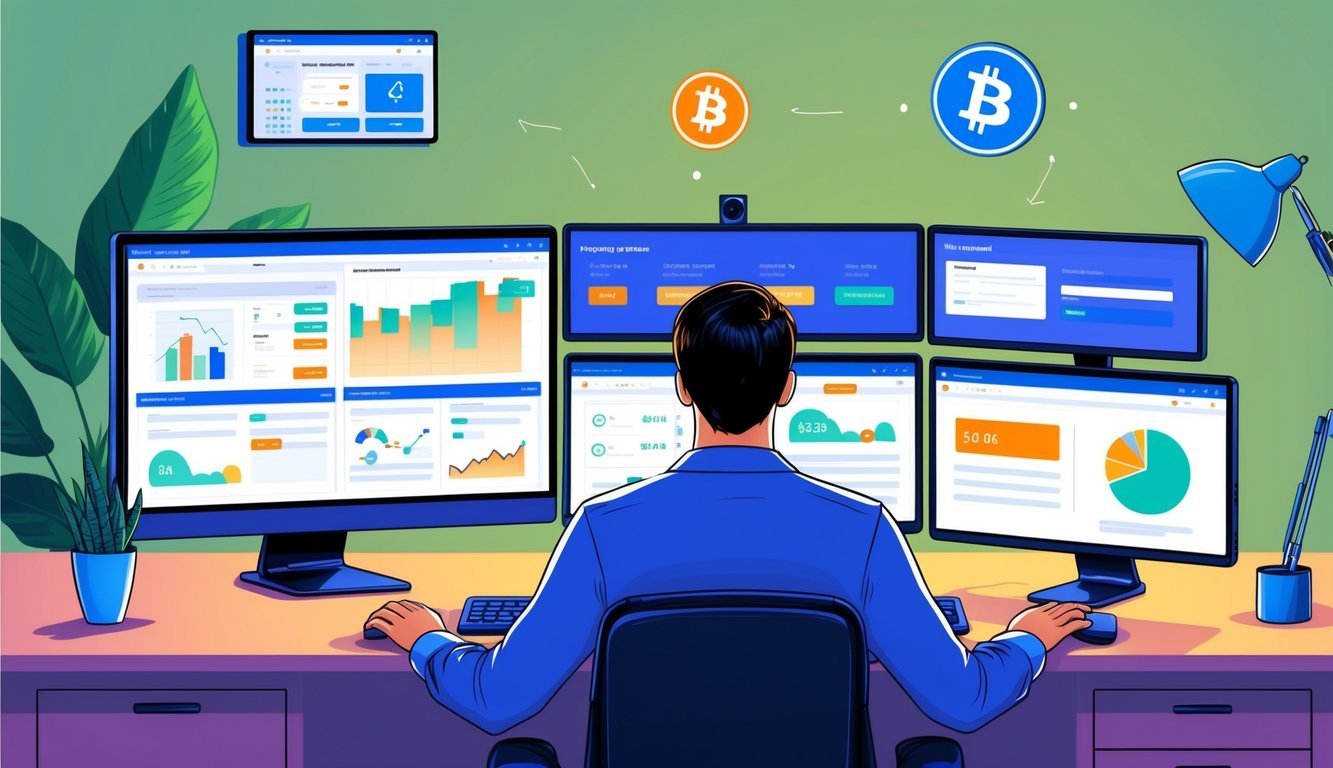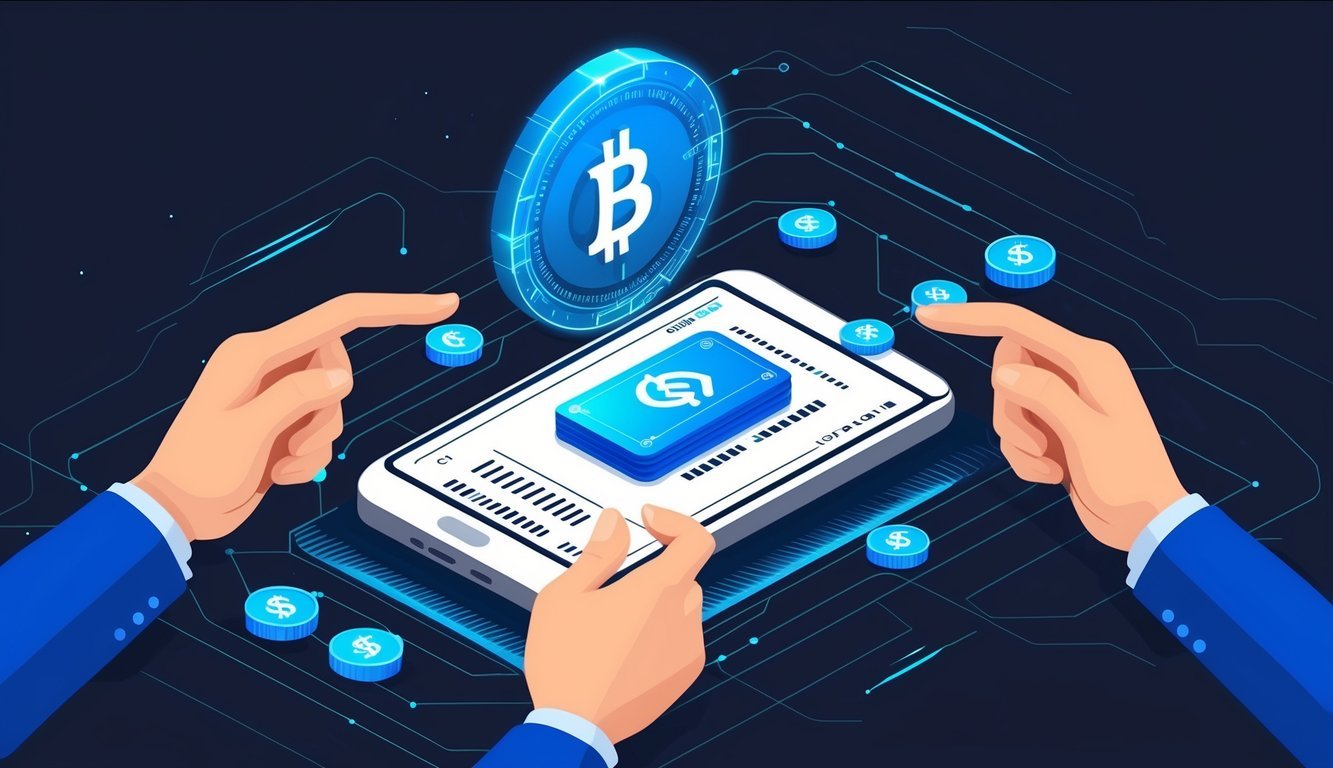Digital money is changing how we think about cash. More people are looking to buy it, but it can seem tricky at first.
To buy digital currency, you need to pick a trusted platform, set up an account, and transfer funds to make your purchase.

Getting started with digital money is easier than you might think. You can buy small amounts to test the waters or go all in if you’re feeling bold. The key is to do your homework and understand what you’re buying.
Digital currency isn’t just for tech experts anymore. Regular folks are getting in on the action too. It’s a new way to invest, and some see it as the future of money. But remember, it can be risky, so only invest what you can afford to lose.
Key Takeaways
- Choose a secure platform to buy and store your digital currency
- Start small and learn as you go when investing in cryptocurrency
- Keep your digital money safe by using strong passwords and two-factor authentication
Understanding Digital Currencies
Digital currencies are changing how we think about and use money. They offer new ways to store value and make payments without banks. Let’s look at what cryptocurrencies are, how they work, and the different types you might come across.
What Are Cryptocurrencies?
Cryptocurrencies are digital or virtual money that use special codes to keep them safe. Unlike regular money, no bank controls them. Bitcoin was the first and is still the most famous. You can use cryptocurrencies to buy things or as a way to invest.
Crypto works differently from the money in your bank. You store it in a digital wallet instead of a bank account. When you want to send some to someone, the transaction gets checked by a network of computers.
Some popular cryptocurrencies besides Bitcoin include Ether, Dogecoin, and many others called altcoins. Each has its own features and uses.
The Technology Behind Crypto: Blockchain
Blockchain is the tech that makes cryptocurrencies possible. Think of it as a big digital book that everyone can see but no one can change easily. Here’s how it works:
- When you make a transaction, it’s added to a “block” with other transactions.
- This block is then linked to previous blocks, forming a chain.
- Computers all over the world check these blocks to make sure they’re correct.
This system makes it hard to cheat or fake transactions. It’s also used for more than just crypto. Some companies use blockchain to track products or store important info.
Types of Digital Assets
Digital assets go beyond just cryptocurrencies. Here are some types you might come across:
- Coins: These are like digital versions of money. Bitcoin is the most well-known.
- Tokens: These can represent ownership of something or give you rights to use a service.
- Stablecoins: These try to keep a steady value, often tied to real-world money like dollars.
Each type has its own use. Coins are for spending or investing. Tokens might let you use a specific app or service. Stablecoins aim to be less jumpy in price, making them good for everyday use.
Some digital assets, like certain tokens, can even represent real-world items like art or property. As this field grows, we’re seeing more creative uses for these digital tools.
Choosing a Platform for Trading

Picking the right platform to trade digital currencies is crucial. You’ll want to consider factors like fees, security, and available cryptocurrencies. Let’s explore the key aspects to help you make an informed choice.
Centralized vs. Decentralized Exchanges
Centralized exchanges are run by companies and act as middlemen. They’re easy to use and offer lots of features. Coinbase and Kraken are popular centralized options.
Decentralized exchanges, or DEXs, connect buyers and sellers directly. They give you more control but can be trickier to use. Bisq is an example of a DEX.
Each type has pros and cons:
- Centralized: More user-friendly, better customer support
- Decentralized: More privacy, no need to trust a company
Think about what matters most to you when choosing.
What to Look for in a Crypto Exchange
When picking an exchange, keep these things in mind:
- Fees: Look for low trading and withdrawal fees.
- Security: Check if they use cold storage and have insurance.
- Coin selection: Make sure they offer the coins you want to trade.
- User interface: It should be easy to navigate and use.
- Liquidity: Higher trading volume means easier buying and selling.
Don’t forget to check if the exchange is available in your country. Some might have restrictions.
Popular Cryptocurrency Platforms
Here’s a quick look at some top platforms:
- Crypto.com: Great overall user experience
- Coinbase: Perfect for beginners
- Robinhood: Good for stocks and crypto in one place
- Gemini: Known for strong security measures
Each platform has its strengths. Coinbase is super easy for newbies. Robinhood lets you trade stocks too. Gemini focuses on safety.
Try out a few to see which feels right. Most offer demo accounts so you can test them out risk-free.
The Process of Investing in Digital Currency
Buying and trading crypto involves several key steps. You’ll need to choose a platform, set up secure storage, and understand fees and order types. Let’s explore the essentials of getting started with digital currency investments.
How to Buy and Store Crypto
To start buying cryptocurrency, you’ll need to pick an exchange or broker. Popular options include Coinbase, Binance, and Gemini. Create an account and verify your identity.
Next, link a payment method like a bank account or credit card. Once set up, you can buy crypto by placing an order on the platform.
After buying, you’ll need to store your crypto safely. You have two main options:
- Hot wallets: Online storage, convenient but less secure
- Cold wallets: Offline storage devices, more secure but less convenient
For small amounts, the exchange’s built-in wallet might work. For larger investments, consider a cold wallet like Ledger or Trezor.
Understanding Trading Fees and Order Types
When trading crypto, you’ll encounter various fees. These may include:
- Deposit fees
- Trading fees
- Withdrawal fees
Fees vary by platform, so compare options before choosing. Some exchanges offer lower fees for high-volume traders.
You’ll also need to understand order types:
- Market orders: Buy or sell at the current price
- Limit orders: Set a specific price to buy or sell
- Stop orders: Trigger a market order when a certain price is reached
These tools help you manage risk and execute trades according to your strategy.
Strategies for Crypto Investment
Developing a solid investment strategy is crucial for crypto success. Here are some popular approaches:
- Dollar-cost averaging: Invest fixed amounts regularly
- HODLing: Buy and hold for long-term gains
- Trading: Buy low, sell high based on market trends
Consider diversifying your crypto portfolio to spread risk. You might invest in major coins like Bitcoin and Ethereum, along with some promising altcoins.
Staking is another option for earning passive income. By locking up your crypto, you can earn rewards over time.
Always do your research before investing. Stay informed about market trends and new developments in the crypto world.
Security and Advanced Features

Keeping your digital currency safe is crucial. Many exchanges offer extra perks to boost your crypto experience.
Ensuring Safety and Security
Cybersecurity is a top priority for crypto exchanges. They use complex systems to guard your assets. You’ll often find two-factor authentication (2FA) as a basic security measure. This adds an extra layer of protection to your account.
Some platforms store most funds in offline “cold storage.” This keeps your crypto away from online threats. You should also use strong, unique passwords for your accounts.
Look for exchanges that offer insurance on your holdings. This can protect you if the platform gets hacked.
Always be careful with phishing attempts. Don’t click suspicious links or give out your info to unverified sources.
Advanced Trading and Rewards
Many exchanges have an ActiveTrader feature for pros. This gives you access to advanced charts and order types. You can set limit orders, stop losses, and use margin trading.
Some platforms offer staking. This lets you earn rewards on certain cryptocurrencies you hold. It’s like earning interest on your crypto.
Rewards programs are common too. You might get cashback or crypto for trading or referring friends.
Look for exchanges with low fees, especially for high-volume traders. Some use maker-taker fee models to encourage liquidity.
SEPAs (Single Euro Payments Area) transfers are often available for European users. This can make bank transfers faster and cheaper.
Frequently Asked Questions
Buying digital currency can seem confusing at first. But it’s actually pretty simple once you know the basics. Here are some common questions to help you get started.
How can a beginner purchase digital currency?
To buy crypto as a newbie, start by picking a reputable exchange like Coinbase. Create an account and verify your identity. Then link a payment method like your bank account or debit card.
Choose which cryptocurrency you want to buy. Bitcoin and Ethereum are popular choices for beginners. Enter how much you want to purchase and complete the transaction.
What’s the easiest way to buy crypto using a debit card on platforms like Coinbase?
Using a debit card is one of the quickest ways to buy crypto. On Coinbase, link your card to your account. Select “Buy/Sell” and choose your desired cryptocurrency.
Enter the amount you want to buy and select your linked debit card as the payment method. Review the details and confirm your purchase. The crypto will show up in your wallet right away.
Can you cash out digital currency into real money?
Yes, you can convert crypto back to regular money. Sell your cryptocurrency on an exchange for your local currency. Then withdraw the funds to your linked bank account.
Keep in mind that you may owe taxes on any profits. The process can take a few business days for the money to reach your bank.
What are some basic security tips for buying digital currencies?
Use strong, unique passwords for your crypto accounts. Enable two-factor authentication for an extra layer of security. Don’t share your private keys or recovery phrases with anyone.
Consider using a hardware wallet to store large amounts of crypto offline. Be wary of scams and only buy from trusted exchanges. Keep your computer and phone updated with the latest security patches.
Are there any legit ways to snag some cryptocurrency for free?
You can earn small amounts of free crypto through various methods. Some exchanges offer sign-up bonuses or rewards for completing educational courses about crypto.
Faucets give out tiny amounts of crypto for completing tasks. Some apps and games also offer crypto rewards. Just remember, these methods won’t make you rich overnight.
Is investing in digital currencies actually a smart move?
Crypto can be a high-risk, high-reward investment. It’s known for its volatility, with prices that can change rapidly.
Only invest what you can afford to lose.
Do your research and understand the technology behind the cryptocurrencies you’re interested in.
Consider crypto as part of a diversified investment portfolio.
Consult with a financial advisor to see if it fits your overall financial goals.




